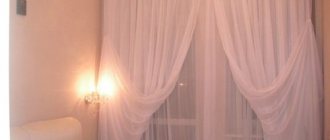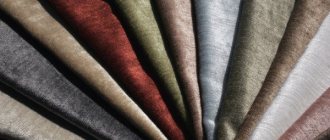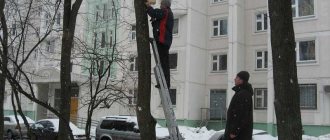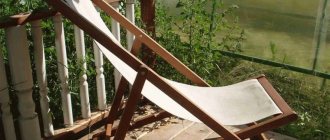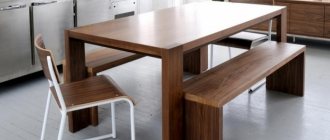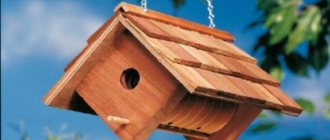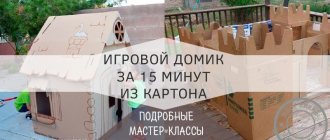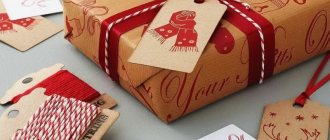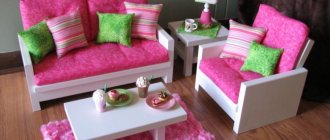In this article we will make birdhouses with our own hands - correct, beautiful (simple and unusual) houses for birds . I decided to break down this topic of birdhouses into clear points , so it will be more convenient to navigate the article. And before I give specific drawings and diagrams for assembling birdhouses, and tell you how to make a birdhouse, we will talk about important things - the location and method of attaching your birdhouse. After all, the model of the house also depends on what fastening methods you have available, and on whether you will mount your bird house on a tree or on special high structures. And one more thing ... before moving on to choosing the design of your future birdhouse, we will deal with the most common mistakes in making birdhouses (in order to avoid them in our homemade house). So here you will find answers to the following questions:
- How to attach birdhouses to a tree (types of fasteners for bird houses)
- Where can you attach birdhouses ( if there are no trees nearby ).
- The main mistakes when creating a bird house.
- How to help birds choose your birdhouse.
- Drawing and assembly diagram of a classic birdhouse.
- multi-person, multi-apartment bird houses.
- Houses for birds of non-standard shapes.
- Birdhouses made from non-traditional materials (boots, cans, teapots, pots, etc.)
Even more ideas and tips on how to make houses for birds in the article “DIY BOOKING BOARDS (10 methods, drawings, rules).”
After studying this article, you can make a birdhouse yourself for a competition in kindergarten or school . Or buy a ready-made set of blanks for a birdhouse - assemble it and decorate it according to your own design.
on the tree.
Birdhouses are usually tied to a tree with a rope. To do this, a thick long beam is nailed to the back wall of the house. It is leaned against a tree and a rope is wrapped repeatedly around it - wrapping the beam and the tree trunk at the same time.
But in the West, birdhouses are often nailed to a tree (it’s harder to tie, easier to nail, although it’s cruel to an adult tree). To do this, the back wall of the birdhouse is made a little higher in height - so that there is a protrusion of the board on top where nails can be driven in.
In the same way, you can make this upper projection of the back wall even longer. Long enough to drill a hole in it and hang it on a rope or iron hook as in the photo below.
You can also drive a hook into the roof of the house and use it to hang a birdhouse on a chain or rope on a thick and strong tree branch at your dacha.
SUPPORT FOR THE NIGHTBOOK.
In addition to wood, any tall structure made from scrap materials can serve as a support for a birdhouse. This could be a large branch cut from an apple tree. It can be dug into the ground. But you should understand that on such a support the birdhouses will be too low above the ground, and it will be easy for cats to reach the house (this will alarm the bird). This support model is good in cases where there are no cats in the area and you have a quiet nook in the yard where even your “human foot” almost never sets foot.
Therefore, to maintain the bird’s sense of safety, it is necessary to make high structures of supports for wooden birdhouses. For example, such as in the photo of bird houses below.
Also, an original portal in the form of a pergola can serve as a support-pedestal for a bird house. But also for places with infrequent traffic. If people wander back and forth through this portal, the birds will not want to settle. It is better to place such a pergola in a quiet corner of your garden and not visit it often. Birds will appreciate the solitude and wilderness and will choose this place for safe breeding.
But in the photo below we see that holders for simple wooden birdhouses can be very different from beams with decorative carpentry to ordinary old garden forks stuck into compacted earth.
Also, the support post for your new birdhouse, made by yourself, can be interestingly decorated with fresh flowers. If you plant a climbing plant near a pole, or hang pots of flowers as in the photo with birdhouses below.
What to make a birdhouse from?
Of course, the best material for a poultry house will be natural wood. This can be: oak, birch, maple and other types of wood. An exception to the list of permitted woods are conifers: they contain resin, which is harmful to many birds.
To make a birdhouse, you can use not new boards, but disassembled old furniture, but preferably not heavily painted or varnished.
As for painting, you can hear different versions. Some are categorically against it, while others are for it. The birdhouse can be decorated in various ways on the outside, but the inside of the tree should be left in its original form. All finishing work is done for beauty.
As for the birds themselves, they live both in a house decorated with paint and in an ordinary wooden one. The main thing is that it is convenient and comfortable, does not leak, and a good entrance to the house is also appreciated. So don’t worry about painting, you just need to do it to your taste and color, and your feathered friends will appreciate the properly executed interior.
in bird houses.
Very often you can see WRONG birdhouses made with errors. Such beautiful painted bird houses are certainly cute and beautiful, but the birds don’t want to live in them. And the houses just hang empty on the tree - purely for decorative purposes.
Let me tell you what mistakes craftsmen make in making birdhouses. So that the bird house made by your own hands is not only beautiful, but also initially correct . Then the birds will like your homemade birdhouse at first sight.
MISTAKE #1
entry hole too low.
The window-door in the birdhouse must be located at a height of at least 30-40 cm. This height is needed so that the bird has the opportunity to create a nest at the bottom of the house.
By the way, the photo above is an example of another fastener - a metal U-shaped bracket is nailed to the roof of the bird house (like an eye for latch bolts).
Look, on the transparent birdhouses in the photo below we can see that the bird is dragging more branches into the house. And if the window is low, the branches will block the exit from the house and it will be impossible for the bird to get out of it. And the bird itself does not want to sit in a nest where its head will be level with the window, it will be so anxious. It is much safer if the window is high - and the wind does not blow on the wet, unfledged chicks, and the mother bird feels safe.
By the way, the photo above shows the original model of the birdhouse, the back wall of which is made of glass with suction cups. Such a house is mounted on a window in a large house and you can watch the birds settling in the nest. You just need to comply with the condition - a window. In the place of the window glass where you plan to mount such a birdhouse on suction cups, you must first seal it with tinting film - so that the birds do not suspect third-party observation.
MISTAKE #2
hole too big.
Starlings will not settle in a house with a door large enough for the cat's head. Cats love to climb trees in search of nests of defenseless chicks. And such a house with a large hole is easy prey for them.
The small hole of the birdhouse was not invented in vain. The cat's head and paw should not fit into the hole, but starlings and other birds should calmly climb inside. Therefore, when you make a birdhouse with your own hands, make a small hole in it.
Only if you live near a forest line and are making houses for owls flying in the vicinity, then a large hole will of course be appropriate.
MISTAKE #3
BRIGHT COLORING of a birdhouse.
If you do not live in a blooming jungle, and if the house you are planning is not designed for parrots with bright plumage, there is no need to paint it in bright colors. Birds trust only natural colors and natural materials. This birdhouse is good to use as a designer piece for your living room or as a piece for a competition for a school or kindergarten. But birds will not live in it.
Mossy, aged houses are much nicer for feathered mothers than sleek, glamorous, smoothly planed apartments.
And if you want your bird house to be original and beautiful, then know: you can make a decorative glamorous design in natural shades. Here in the photo below is just an example of such a house, which at the same time looks chic from an aesthetically human side and does not scare away birds at all with its bright colors.
But the houses that are dearest to the feathered heart are those that are maximally disguised as an ordinary hollow in a tree. After all, starlings initially settled in hollows. From time immemorial it has been this way - it is embedded in their bird genes: to look for a hollow. So make them an artificial hollow from slabs of rough bark ( sold as firewood).
Or take your house made of planed boards and additionally decorate it as a living hollow - cover (or glue) it with twigs, branches and pieces of bark.
Birds love houses made of unplaned wood, with elements of bark and rough branches.
MISTAKE #4
There is no bird stand.
It is inconvenient for birds to climb the smooth boards of a wooden house. It's hard for them, their little claws slip off.
This is especially important for the INNER SIDE of the walls of the birdhouse. It is better to line the inner front wall with small slats-ladders (so that the bird inside can climb along them to the exit window).
Or nail a piece of bark, or an old grater, or, in short, any ribbed and rough surface to the inner wall of the birdhouse. Or place a short inclined board inside the birdhouse (from the bottom to the window) so that the bird can climb up this slide to the exit of the house.
Also, if the outside of your birdhouse is made of smooth planed boards, make sure that the bird has a footrest.
These could be simple twigs or branches that you cut while pruning apple trees in the garden.
These can be river pebbles glued with hot glue from a glue gun. Or, instead of pebbles, you can stick on logs of branches (cut them into round saw cuts and paste them over the house).
Any old, rusty thing from the barn is suitable as a stand for the birds' legs - a door hinge, a valve from a water pipe, a faucet, a reel from an old fishing rod, a rake, an aluminum fork, a key. Anything can become a perch-stand in a homemade birdhouse.
Such things will only add originality and creativity to your simple bird house.
WHAT ELSE
we can
HELP THE BIRDS.
In addition to hard branches, to build a nest, birds need soft material - tufts of dry grass, moss, feathers, rag debris, pieces of paper, which they collect everywhere themselves, spending long hours on low-level search flights.
Why not make the bird's work easier and place a construction warehouse next to the bird's home. Housewarming in your birdhouse will come much earlier if everything you need to create comfort is located next to the house.
You can collect bunches of grass yourself, tear the cotton wool into pieces and place it in such a way that it is easy for the bird to pull out pieces of material from this construction warehouse. There is no need to tie the grass into tight bunches with thread - the bird will not be able to pull the grass out of the tight bunch. You need to make storage out of a mesh container.
You can hang a box with rags, cotton wool and moss nearby. To prevent the wind from blowing the material away, the box can be covered with a mesh (metal) or a plastic mesh, which we place on the bottom of the kitchen sink.
Or weave and twist balls from flexible branches and insert cotton wool, centipon and pieces of chopped newspaper or toilet paper inside such woven balls.
Even holders for bird fleeces and rags specially made for this purpose are sold. They are installed or hung next to birdhouses.
Material for the construction of birdhouses.
The MATERIAL for the house must have the correct characteristics of thickness and texture.
THICKNESS. Boards 2 cm thick. This thickness of a wooden board will better retain the heat of the house. After all, nests are built in the spring, when the nights are still quite cold and even frosty.
TEXTURE. As I already said, the boards should be rough (slab boards with unplaned bark are suitable). And if you only have smooth planed boards, you can stuff pieces of bark on them with nails and stick them on liquid nails (thick adhesive from spray cans).
Or create artificial roughness - scratch the inner wall of the birdhouse with a knife - make notches for the bird to cling to. Or nail pieces of bark onto the inner wall, several slats one after another like a ladder, or nail a grater or a piece of insulation (it is made of foam and it will also be convenient for the bird’s claws to climb on it).
You CANNOT make houses from glue boards (plywood, chipboard, fiberboard - these materials contain adhesive resins, they emit toxins that the birds may not like. I don’t know whether it’s true or not, but they say that resin pine boards are also not suitable for a birdhouse, which In the warm sun, the resinous board heats up and releases stinking resin, and that this is supposedly harmful to the birds. I haven’t checked it, I can’t presume to say.
Now I will give diagrams and drawings of simple houses. But I’ll immediately make a reservation that your designs can be completely different in shape and size. You are free not to adhere exactly to the outline from the project below. As you already understood from the photographs above, there are a variety of houses.
But the logic of the sizes must be preserved... And this logic is as follows.
What are the dimensions of a proper birdhouse?
The size of the window hole (called a tap hole) is no more than 5 cm in diameter. So that the crow cannot stick its head into the birdhouse and eat the chicks. And the cat's head didn't get in there either.
The height of the entrance window is at least 20 cm from the bottom of the house. So that the wind from the window does not blow on the nest of the chicks, and that the chicks are not near the entrance - because of the danger of meeting a crow's beak or the clawed paw of a cat.
The height of the birdhouse is at least 35 cm. It can be a little higher, but remember that if you make the ceiling too high, then such a high-ceilinged house will be harder for the birds to warm (warm air will go up and the birds below in the nest will freeze).
The width of the house (that is, the square area of its floor) should also not be very large. A spacious house is not considered cozy and a wide nest requires a longer time to build. The bird will be tortured to fill such a spacious house with twigs. Therefore, we try to stick to the bottom size of 15 x 15 cm (or 20 x 20). That is, if you are making a wide house, then put dry grass there in advance (the bird will only be happy).
As you can see, these dimensions are dictated by the logic of survival in the wild . And the right birdhouse is the one in which all these features are observed.
Well, now let's move on to the drawings and diagrams.
Here I have collected ways to make a birdhouse in the form of diagrams and drawings . You can choose your house model and estimate what parts you can assemble it. And remember, it doesn’t matter if your sizes differ slightly - we make them from available material and therefore the sizes will depend on our availability.
Here is another drawing of a birdhouse, although here the dimensions are given in inches. It will be easier for you to convert inches into centimeters if you ask your wife for a measuring tape for patterns - the one she uses to measure the circumference of her losing weight during a diet. On such a measuring tape, centimeters are written on one side and inches on the other. This way you can always see a quick conversion of any inch size to centimeter.
These drawings do not take into account one more CONDITION. In the Soviet birdhouses of our childhood there was always a clear rule: the front front wall (the one with the hole) should be tilted forward . This was done so that the starling could climb up such an inclined hill to the exit from the house.
To maintain this slope, you need to make 2 side walls from the rear edge straight vertically - and from the front edge obliquely (we see a similar principle of oblique side walls in the photo below). Only in this example does the birdhouse have a triangular side section. And in Soviet birdhouses there was such a slope, but at the same time there was also a normal bottom, so that there was enough space for the nest.
Below we see a drawing of real Soviet birdhouses from our childhood. True, the dimensions here are given in inches.
But if your house does not have a bevel on the sides, then to make it easier for the bird to escape, you can put an inclined board on the front wall on the inside of the house (it will perform the same function as a ladder).
Now let's look at birdhouses of another unusual shape - a rhombus. Here he is in the photo. The idea is certainly beautiful, the house turned out elegant and decorative. But from a practical point of view, it would be better for the birds if the window was located closer to the left or right edge - then the inclined plane of the wall would serve as a support for the bird to comfortably climb out.
drawback in this house is that the window is too low - there is no place for a nest - it turns out that when the bird puts grass and twigs there, the height of the chicks will coincide with the height of the window - and they will look straight out and any crow will pull it out with its beak and eat it without a twinge of conscience.
An intelligent feathered mother would never choose such a dangerous house for housing - and it will just hang in your garden, and you will wonder why the birds do not move into the birdhouse.
Here is a drawing of a similar house, but here the entrance hole itself is located much higher - it’s better that way. Or better yet, raise it right under the roof of the birdhouse. The bird will approve of this option.
A little history
People started building houses for birds not very long ago. Birdhouses appeared in everyday use among citizens of our country approximately 300 years ago. For the first time, the idea of building houses for feathered friends was introduced in Europe in the 15th-16th centuries. Only there the goal was pursued more for the benefit of people, namely, they loved to eat birds as a delicacy and caught them for meat.
Therefore, the decision was made to take advantage of the gifts of nature and catch the bird in a birdhouse near your home. Bird houses were also built near restaurants and taverns in order to quickly deliver free goods to the establishment’s cook.
Birdhouses were brought to the lands of Russia during the time of Peter I. In his personal use and in the everyday life of people during his reign, many different Western things were presented, which were presented as innovations in a developing power. The tradition of having a haven for birds near your home has been preserved to this day in our country. And the people who take care of the houses for them and put their living things there are spoken of as very good owners, caring not only about themselves.
Duplyanka
In order to cut a birdhouse from a wooden block, it is more convenient to use a chainsaw. Brief instructions for creating such a birdhouse are as follows.
To begin work, you need to firmly install the deck in a vertical position. The proposed cut is divided into three equal parts: the upper one for the roof slopes, the middle one for the hollow and perch, and the other third for the nest.
First, the upper slopes for the roof are cut at an angle of 45 degrees. Then, as smoothly as possible, the core is removed along its entire height and an entrance hole is cut. And only after this the birdhouse is cut off from the deck along the bottom line.
Plywood
This material is light, beautiful and functional, but you cannot make a house out of it. The production of plywood uses chemicals that will cause serious harm to the health of the chicks.
Materials and tools
To make a classic birdhouse you need:
- boards, preferably pine, or a log of suitable width;
- screws, nails of different sizes;
- acrylic weather-resistant paints - if you will paint the product;
- putty for wood processing - fill cracks if necessary.
As for tools, you need:
- hand hacksaw or jigsaw;
- drill with a cutter for cutting out a tap hole;
- screwdriver;
- screwdriver;
- hammer;
- pencil, ruler, protractor, compass.
In addition to tools, a comfortable table is no less important for work.
Manufacturing
The first thing you may need before making a birdhouse from wood with your own hands is drawings. You can make them yourself, based on the dimensions given above, or take ready-made ones. If you decide to make a nest box, you just need to find a log or a piece of tree trunk of a suitable diameter.
Birdhouse made of boards
All wooden birdhouses are built using the same algorithm. This is the simplest design that even a teenager can handle. Let's give an example of a house with a flat roof.
Drawing for cutting parts Source wp.com
- Transfer the markings of the parts to the boards in accordance with the dimensions in the drawing.
- Cut them with a hacksaw, circular saw or jigsaw.
- Make a tap hole on the front wall using a drill with a hole saw or a chisel and hammer.
- Connect the façade to the side walls with nails or self-tapping screws.
- Also secure the bottom and nail the back wall.
- Assemble a cover consisting of two parts - a roof and a sleeve, the dimensions of which coincide with the dimensions of the bottom.
- Insert the bushing into the birdhouse from the top.
For reference! This removable roof structure will allow you to clean and disinfect the birdhouse before each season.
If the gaps at the joints of the parts are no more than 1-2 mm, they do not need to be caulked so that air does not stagnate in the birdhouse. On the contrary, if the structure is built very tightly, it is advisable to drill several small holes in the bottom and one in the upper part of the side walls for ventilation.
Bend or grind off the ends of the nails protruding inside; if the work was not done very carefully, remove sharp, splintered pieces of boards that could injure the birds. And the birdhouse is ready.
To make a sloping or gable roof, you need to cut down the walls at the desired angle.
Parts for a birdhouse with a gable roof Source 3ddd-engineering.ru
General information
A birdhouse is a small home for birds, which especially helps them in the spring. But there are other useful aspects of birdhouses made of plywood or other materials:
- if there is at least one birdhouse at the dacha, the owner will have the opportunity not only to observe the life of small birds, but also to enjoy their sonorous singing;
At what height should you hang a birdhouse?
- birds living in the garden will be able to protect the trees from various pests;
- The manufactured birdhouse is not only a house for birds, but also a decorative element for a summer cottage. Of course, this requires a more creative approach to the design of a wooden structure.
A birdhouse on the site has a number of advantages.
The procedure for making a “bird house,” especially if a simple design was chosen as the project, is quite simple. Achieving success requires desire, diligence and a little free time. Then you just need to follow the instructions.
Parents and their children can build a birdhouse in a few hours if they take note of the recommendations from this review

